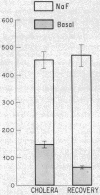Abstract
The enterotoxin of Vibrio cholerae causes copious fluid production throughout the lenght of the small intestine. As this is thought to be mediated by stimulation of adenyl cyclase, a study has been made of the activity and properties of this enzyme in jejunal biopsy tissue taken from patients during the diarrheal phase of cholera and after recovery. Adenyl cyclase activity during cholera was increased more than twofold relative to the enzyme in convalescence. Under both conditions stimulation by prostaglandin E1 (PGE1) and by fluoride was observed. The responsiveness to PGE1 was not altered in cholera; the total activity of the fluoride-stimulated enzyme was similar, a finding that suggests cholera toxin stimulates pre-existing enzyme in the intestinal cell. The enzymes during cholera and convalescence were similar in all other properties examined. Optimal Mg++ concentration was 10 mM; Mn++ at 5 mM stimulated the enzyme but could not replace Mg++ except in the presence of 10 mM fluoride. Calcium was markedly inhibitory at concentrations greater than 10-4 M. The pH optimum was 7.5 and the Michaelis constant (Km) for ATP concentration approximated 10-4 M. Thus the interaction of cholera toxin with human intestinal adenyl cyclase does not alter the basic properties of the enzyme. When biopsy specimens were maintained intact in oxygenated Ringer's solution at 0°C, no loss of activity was observed at 1½ and 3 hr. In contrast, when the cells were homogenized, rapid loss of activity, with a half-life of 90 min was seen even at 0°C. Consequently for comparative assays of human jejunal adenyl cyclase, strict control of the experimental conditions is required. It was under such conditions that a twofold increase in basal adenyl cyclase activity during cholera was observed.
Full text
PDF
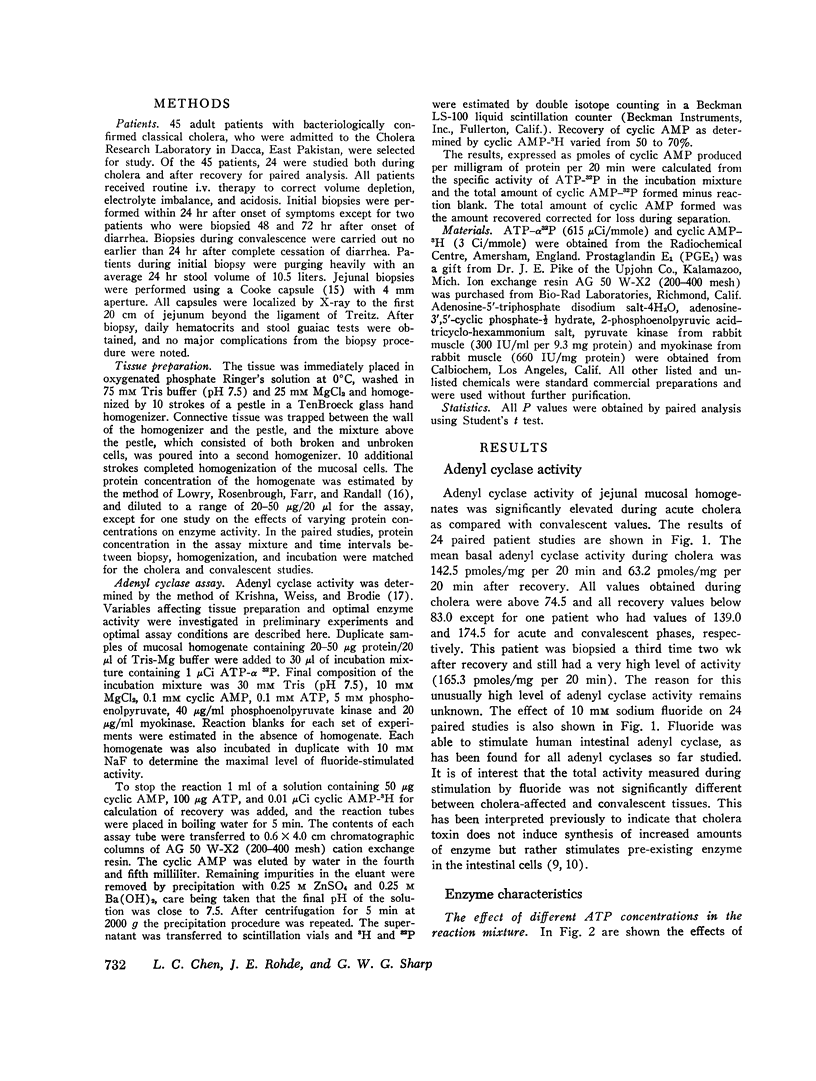

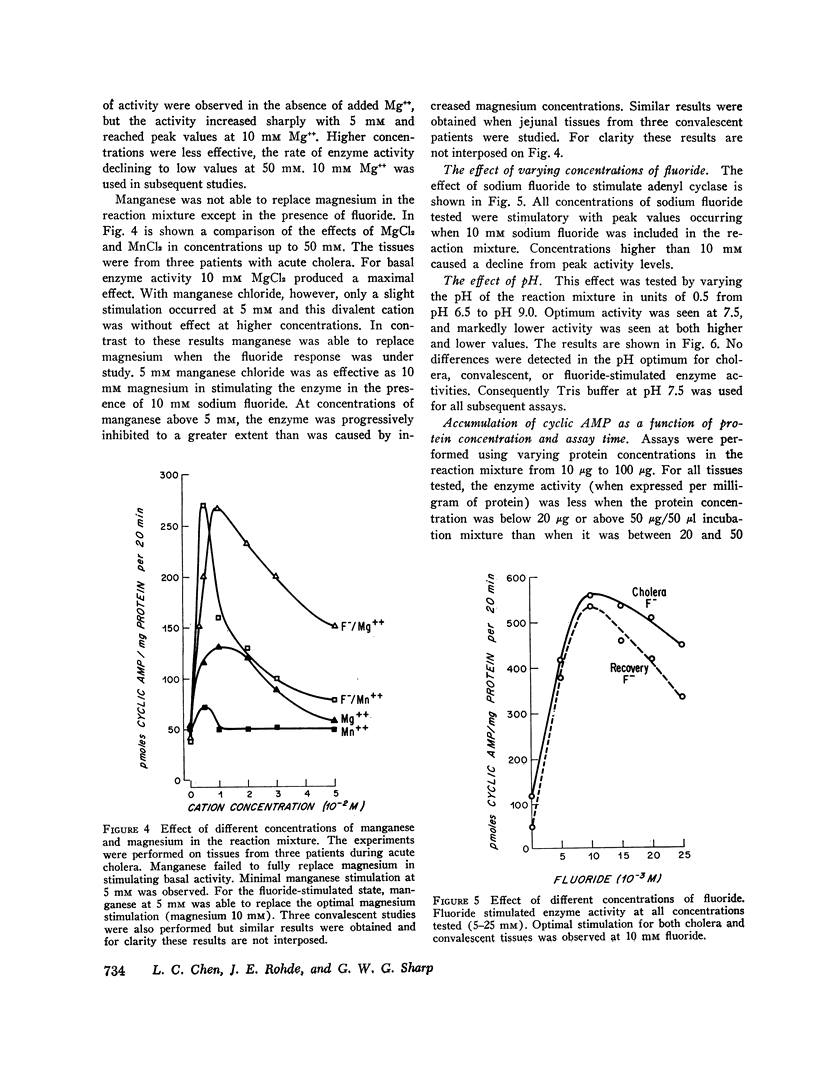
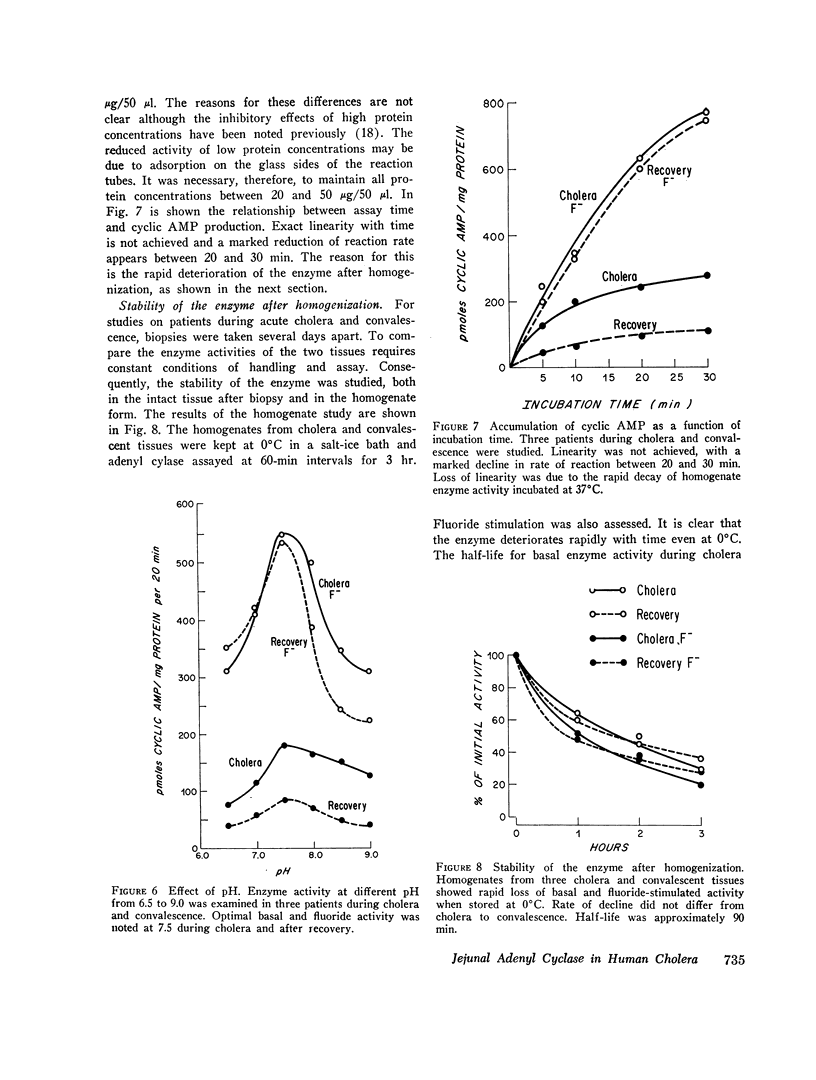
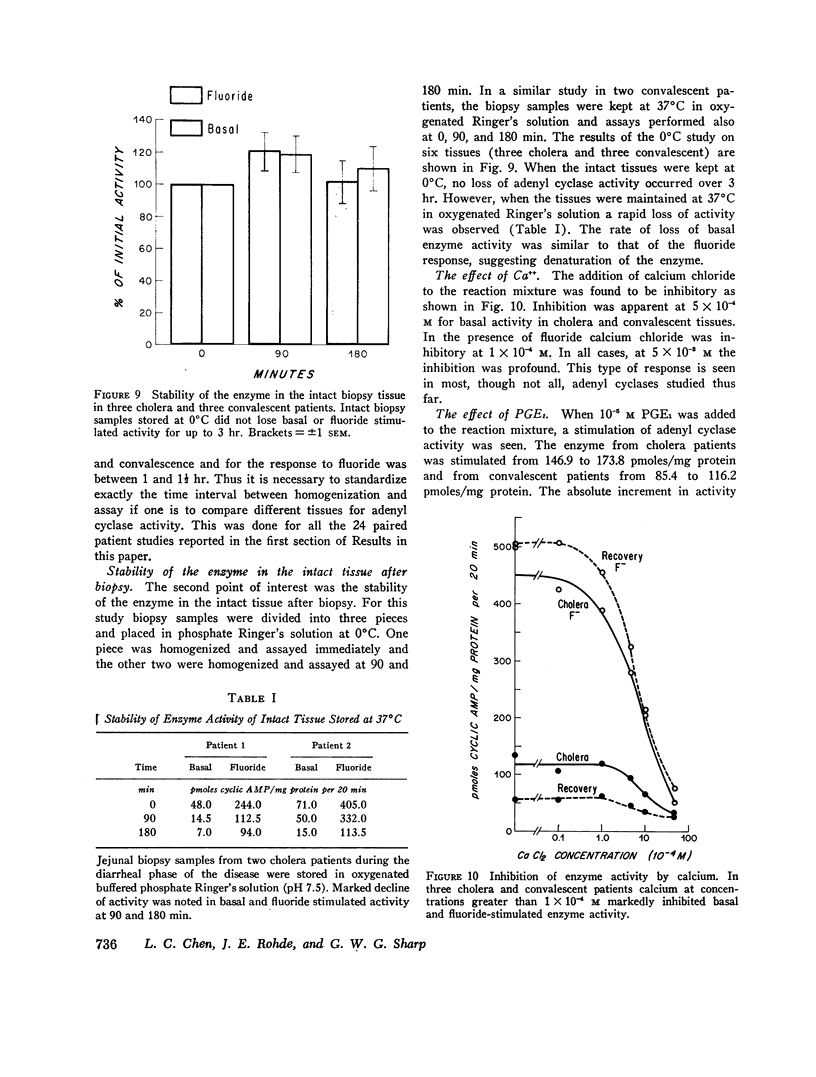
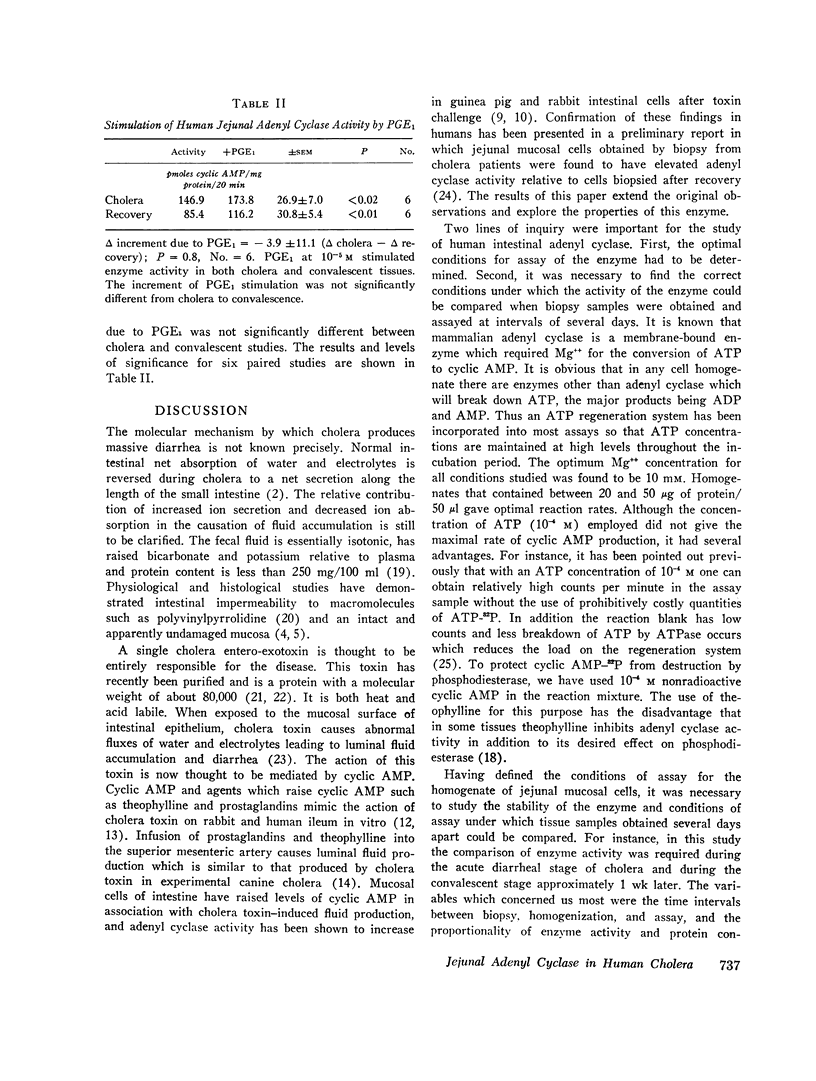
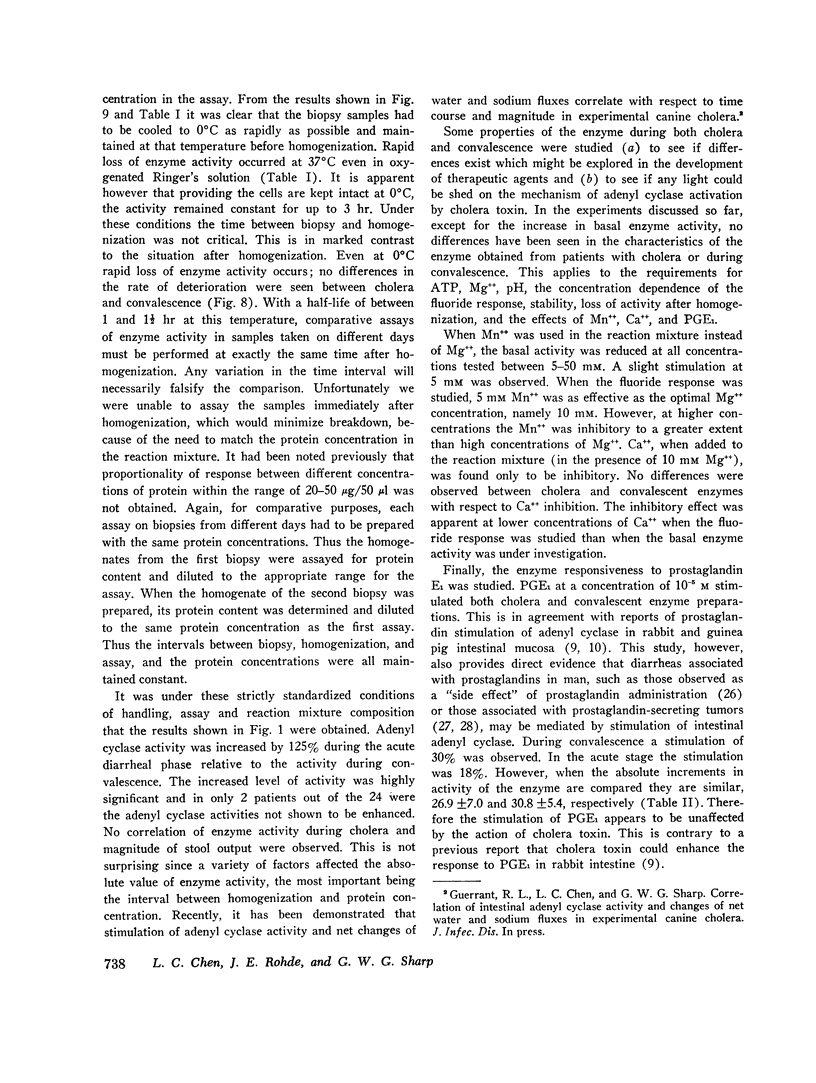
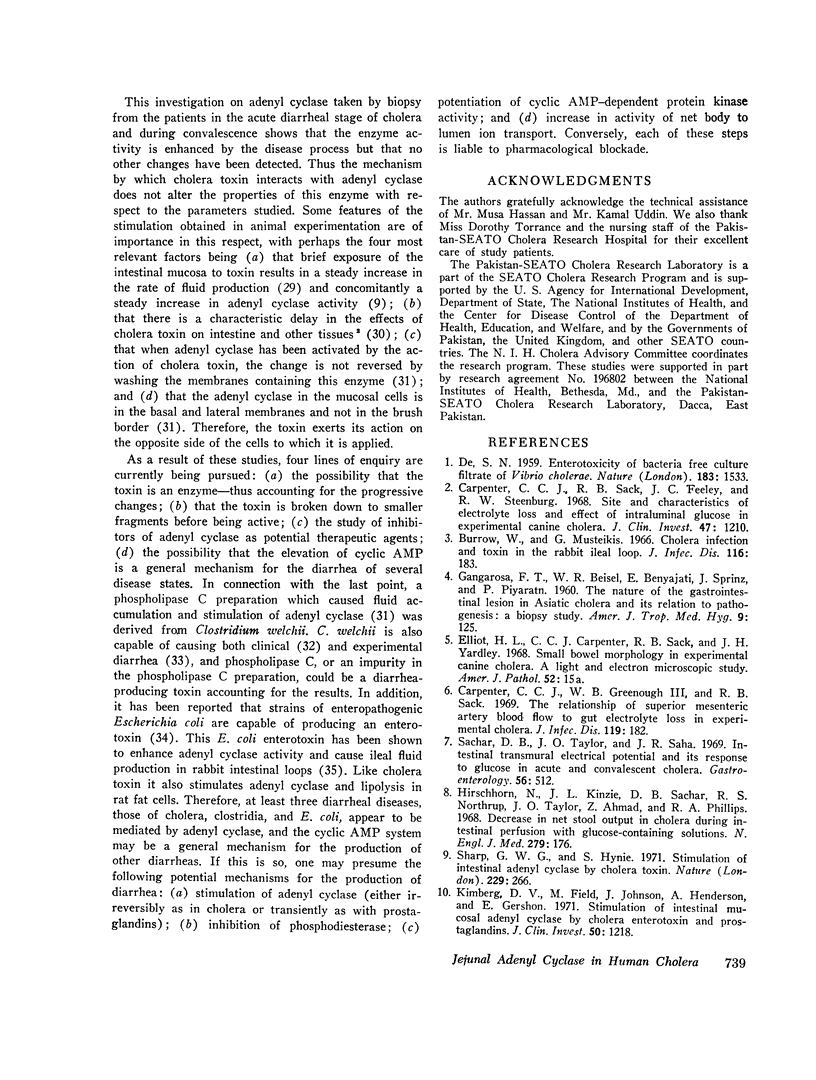

Images in this article
Selected References
These references are in PubMed. This may not be the complete list of references from this article.
- Burrows W., Musteikis G. M. Cholera infection and toxin in the rabbit ileal loop. J Infect Dis. 1966 Apr;116(2):183–190. doi: 10.1093/infdis/116.2.183. [DOI] [PubMed] [Google Scholar]
- Bär H. P., Hechter O. Adenyl cyclase assay in fat cell ghosts. Anal Biochem. 1969 Jun;29(3):476–489. doi: 10.1016/0003-2697(69)90332-7. [DOI] [PubMed] [Google Scholar]
- CHOUDHURY D. C., NICHOLSON G. I., COOKE W. T. SIMPLE CAPSULE FOR MULTIPLE INTESTINAL BIOPSY SPECIMENS. Lancet. 1964 Jul 25;2(7352):185–186. doi: 10.1016/s0140-6736(64)90238-7. [DOI] [PubMed] [Google Scholar]
- Carpenter C. C., Greenough W. B., 3rd Response of the canine duodenum to intraluminal challenge with cholera exotoxin. J Clin Invest. 1968 Dec;47(12):2600–2607. doi: 10.1172/JCI105942. [DOI] [PMC free article] [PubMed] [Google Scholar]
- Carpenter C. C., Greenough W. B., 3rd, Sack R. B. The relationship of superior mesenteric artery blood flow to gut electrolyte loss in experimental cholera. J Infect Dis. 1969 Feb;119(2):182–193. doi: 10.1093/infdis/119.2.182. [DOI] [PubMed] [Google Scholar]
- Carpenter C. C., Sack R. B., Feeley J. C., Steenberg R. W. Site and characteristics of electrolyte loss and effect of intraluminal glucose in experimental canine cholera. J Clin Invest. 1968 May;47(5):1210–1220. doi: 10.1172/JCI105810. [DOI] [PMC free article] [PubMed] [Google Scholar]
- Chen L. C., Rohde J. E., Sharp G. W. Intestinal adenyl-cyclase activity in human cholera. Lancet. 1971 May 8;1(7706):939–941. doi: 10.1016/s0140-6736(71)91443-7. [DOI] [PubMed] [Google Scholar]
- Duncan C. L., Strong D. H. Experimental production of diarrhea in rabbits with Clostridium perfringens. Can J Microbiol. 1969 Jul;15(7):765–770. doi: 10.1139/m69-134. [DOI] [PubMed] [Google Scholar]
- Field M: Intestinal secretion: effect of cyclic AMP and its role in cholera. N Engl J Med. 1971 May 20;284(20):1137–1144. doi: 10.1056/NEJM197105202842008. [DOI] [PubMed] [Google Scholar]
- Finkelstein R. A., LoSpalluto J. J. Pathogenesis of experimental cholera. Preparation and isolation of choleragen and choleragenoid. J Exp Med. 1969 Jul 1;130(1):185–202. doi: 10.1084/jem.130.1.185. [DOI] [PMC free article] [PubMed] [Google Scholar]
- GANGAROSA E. F., BEISEL W. R., BENYAJATI C., SPRINZ H., PIYARATN P. The nature of the gastrointestinal lesion in asiatic cholera and its relation to pathogenesis: a biopsy study. Am J Trop Med Hyg. 1960 Mar;9:125–135. doi: 10.4269/ajtmh.1960.9.125. [DOI] [PubMed] [Google Scholar]
- Gyles C. L., Barnum D. A. A heat-labile enterotoxin from strains of Eschericha coli enteropathogenic for pigs. J Infect Dis. 1969 Oct;120(4):419–426. doi: 10.1093/infdis/120.4.419. [DOI] [PubMed] [Google Scholar]
- Hirschhorn N., Kinzie J. L., Sachar D. B., Northrup R. S., Taylor J. O., Ahmad S. Z., Phillips R. A. Decrease in net stool output in cholera during intestinal perfusion with glucose-containing solutions. N Engl J Med. 1968 Jul 25;279(4):176–181. doi: 10.1056/NEJM196807252790402. [DOI] [PubMed] [Google Scholar]
- Hynie S., Sharp G. W. Adenyl cyclase in the toad bladder. Biochim Biophys Acta. 1971 Jan 26;230(1):40–51. doi: 10.1016/0304-4165(71)90052-3. [DOI] [PubMed] [Google Scholar]
- Karim S. Action of prostaglandin in the pregnant woman. Ann N Y Acad Sci. 1971 Apr 30;180:483–498. doi: 10.1111/j.1749-6632.1971.tb53216.x. [DOI] [PubMed] [Google Scholar]
- Kimberg D. V., Field M., Johnson J., Henderson A., Gershon E. Stimulation of intestinal mucosal adenyl cyclase by cholera enterotoxin and prostaglandins. J Clin Invest. 1971 Jun;50(6):1218–1230. doi: 10.1172/JCI106599. [DOI] [PMC free article] [PubMed] [Google Scholar]
- Krishna G., Weiss B., Brodie B. B. A simple, sensitive method for the assay of adenyl cyclase. J Pharmacol Exp Ther. 1968 Oct;163(2):379–385. [PubMed] [Google Scholar]
- LOWRY O. H., ROSEBROUGH N. J., FARR A. L., RANDALL R. J. Protein measurement with the Folin phenol reagent. J Biol Chem. 1951 Nov;193(1):265–275. [PubMed] [Google Scholar]
- McNICOL M., McKILLOP E. J. Foodpoisoning caused by Clostridium welchii in cold chicken. Lancet. 1958 Apr 12;1(7024):787–789. doi: 10.1016/s0140-6736(58)91595-2. [DOI] [PubMed] [Google Scholar]
- Pierce N. F., Carpenter C. C., Jr, Elliott H. L., Greenough W. B., 3rd Effects of prostaglandins, theophylline, and cholera exotoxin upon transmucosal water and electrolyte movement in the canine jejunum. Gastroenterology. 1971 Jan;60(1):22–32. [PubMed] [Google Scholar]
- Pierce N. F., Greenough W. B., 3rd, Carpenter C. C., Jr Vibrio cholerae enterotoxin and its mode of action. Bacteriol Rev. 1971 Mar;35(1):1–13. doi: 10.1128/br.35.1.1-13.1971. [DOI] [PMC free article] [PubMed] [Google Scholar]
- Sachar D. B., Taylor J. O., Saha J. R., Phillips R. A. Intestinal transmural electric potential and its response to glucose in acute and convalescent cholera. Gastroenterology. 1969 Mar;56(3):512–521. [PubMed] [Google Scholar]
- Sandler M., Karim S. M., Williams E. D. Prostaglandins in amine-peptide-secreting tumours. Lancet. 1968 Nov 16;2(7577):1053–1054. doi: 10.1016/s0140-6736(68)91528-6. [DOI] [PubMed] [Google Scholar]
- Schafer D. E., Lust W. D., Sircar B., Goldberg N. D. Elevated concentration of adenosine 3':5'-cyclic monophosphate in intestinal mucosa after treatment with cholera toxin. Proc Natl Acad Sci U S A. 1970 Oct;67(2):851–856. doi: 10.1073/pnas.67.2.851. [DOI] [PMC free article] [PubMed] [Google Scholar]
- Sharp G. W., Hynie S. Stimulation of intestinal adenyl cyclase by cholera toxin. Nature. 1971 Jan 22;229(5282):266–269. doi: 10.1038/229266a0. [DOI] [PubMed] [Google Scholar]
- Williams E. D., Karim S. M., Sandler M. Prostaglandin secretion by medullary carcinoma of the thyroid. A possible cause of the associated idarrhoea. Lancet. 1968 Jan 6;1(7532):22–23. doi: 10.1016/s0140-6736(68)90010-x. [DOI] [PubMed] [Google Scholar]



